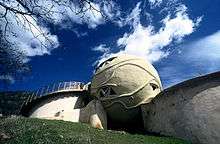Harbin Hot Springs

Harbin Hot Springs is a non-profit hot spring retreat and workshop center at Harbin Springs in Lake County, Northern California. Named after Matthew Harbin, a pioneer who settled in the Lake County area. It is located about two hours northeast of the San Francisco Bay Area, in the United States. The facility was partially destroyed in the Valley Fire in September 2015, and was temporarily closed; as of September 2017 it was announced the resort would reopen in early spring 2018.[1]
History
The baths were commercially developed by settlers in the 1860s, when buildings were erected on the site. The region is prone to wildfires and, over the years, successive lodges have been rebuilt when they burned down. Harbin Hot Springs issued several postcards advertising the resort in the 1920s and 1930s. In the late 1960s and early 1970s, the property was run as a commune with the name Harbinger, "centered around a man named Don Hamrick, a charismatic fellow who wore business suits and combined science with spiritualism in his lectures/sermons". In 1969, Harbinger had about 120 people, but ultimately, the community did not thrive.[2][3]
As of 2012, the clothing-optional retreat center was known as an outdoor spa with a New Age ambiance, where Watsu was developed.[4]
The resort was evacuated because of the Valley Fire on September 12, 2015.[5][6] By September 14, Harbin was almost completely destroyed by the fire with only the pool complex largely intact.[7]
Modern establishment

Robert Hartley (AKA Ishvara) bought the land in 1972 to be a Gestalt center.[8] Sold to the Heart Consciousness Church (HCC) in 1975, Harbin/HCC operates as an intentional community where approximately 150 residents live and operate the Retreat Center for outside visitors.[9] Harbin/HCC maintains a more specifically religious organization, the New Age Church of Being, incorporated in 1996. Harbin is a center for the expression of New Age beliefs. Harbin's clothing-optional policy, its pools, and the natural beauty of the local landscape are part of Harbin's appeal to visitors, who must agree to membership, if only temporarily, for admission.
Harbin has been a center for the development of new modes of healing and personal development, including Watsu (water shiatsu), a massage technique created by Harold Dull at Harbin in the early 1980s.[4] Watsu, based on gently moving the body through water, is now practiced in spas throughout the world.[10][11][12]
Notes
- ↑ "Harbin News". myemail.constantcontact.com. September 2017.
- ↑ Klages 1991.
- ↑ Wester, John (October 21, 2009). "Speed Willy". Anderson Valley Advertiser. Retrieved September 18, 2012.
- 1 2 "Watsu - Dr. Weil's Wellness Therapies". Retrieved September 18, 2012.
- ↑ "Wildfire Forces Evacuation".
- ↑ Rossman, Randi; Payne, Paul (September 13, 2015). "Valley Fire: Devastation During the Night as Fire Destroys Homes". Santa Rosa Press Democrat. Retrieved September 13, 2015.
- ↑ Sernoffsky, Evan (September 14, 2015). "Harbin Hot Springs Ravaged by Valley Fire". San Francisco Chronicle. Retrieved September 14, 2015.
- ↑ Ishvara 2002.
- ↑ McCroskey, Mia (October 30, 2007). "Confessions of a Therme Addict – Harbin Hot Springs, Middletown, California, USA". BootsnAll. Retrieved November 26, 2014.
- ↑ "Watsu". Watsu NYC. Retrieved September 18, 2012.
- ↑ "Welcome to Healing Dance "Proof"". Retrieved September 18, 2012.
- ↑ "Watsu India". Archived from the original on October 22, 2012. Retrieved September 18, 2012.
References
- Klages, Ellen (1991). Harbin Hot Springs: Healing Waters, Sacred Land. Middletown, CA, US: Harbin Springs Publishing. ISBN 0944202012. OCLC 23144182.
- Ishvara (2002). Oneness in Living: Kundalini Yoga, the Spiritual Path, and the Intentional Community. Berkeley, CA, US: North Atlantic Books. ISBN 9781556434136. OCLC 49276954.
Further reading
- MacLeod, Scott (2017). Haiku~ish and Other Loving Hippy Harbin Poetry. Poetry Press at World University and School. ISBN 9780692049037.
- MacLeod, Scott (2016). Naked Harbin Ethnography: Hippies, Warm Pools, Counterculture, Clothing-Optionality and Virtual Harbin. San Francisco, CA, US: Academic Press at World University and School. ISBN 9780692646137. OCLC 968936229.
- Wyne, Sajjad (1997). The Big Bang and the Harbin Experience. Middletown, CA, US: Harbin Springs Publishing. ISBN 0944202101. OCLC 37935329.
- Varner, Gary R. (2009). Sacred Wells: A Study in the History, Meaning, and Mythology of Holy Wells & Waters. New York, NY: Algora Publishing. ISBN 9780875867199. OCLC 457044470.
External links
Coordinates: 38°47′15″N 122°39′14″W / 38.78742°N 122.65379°W